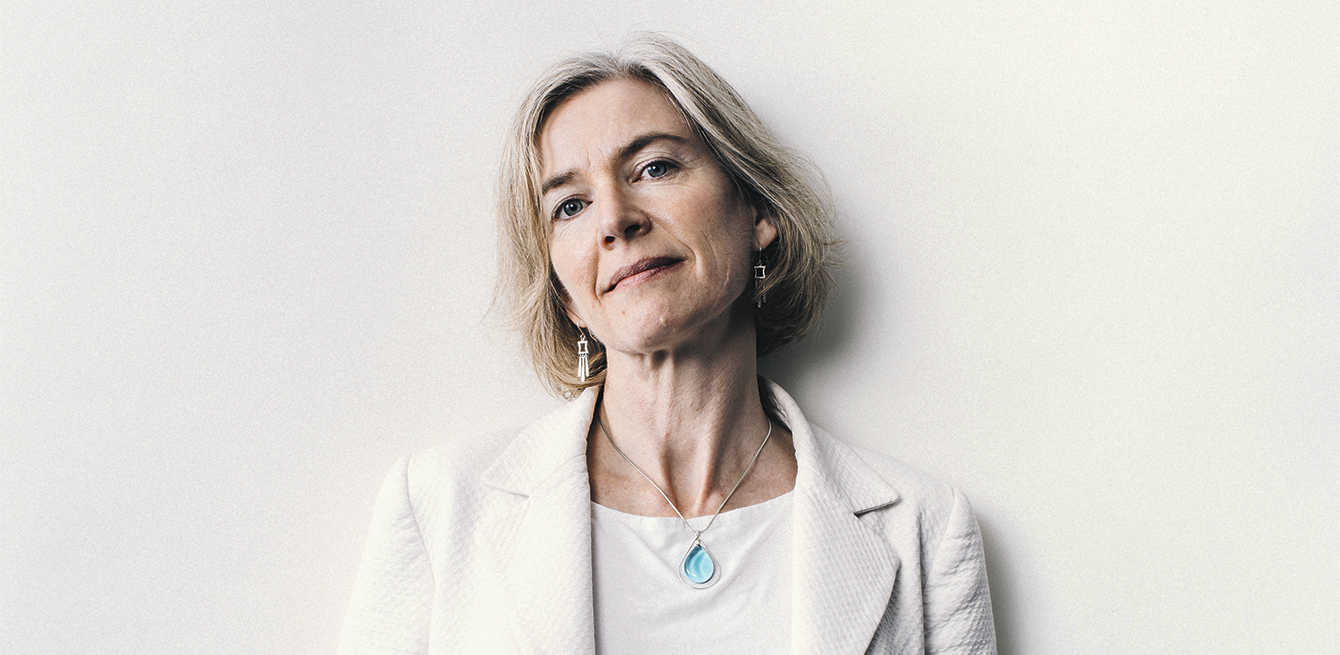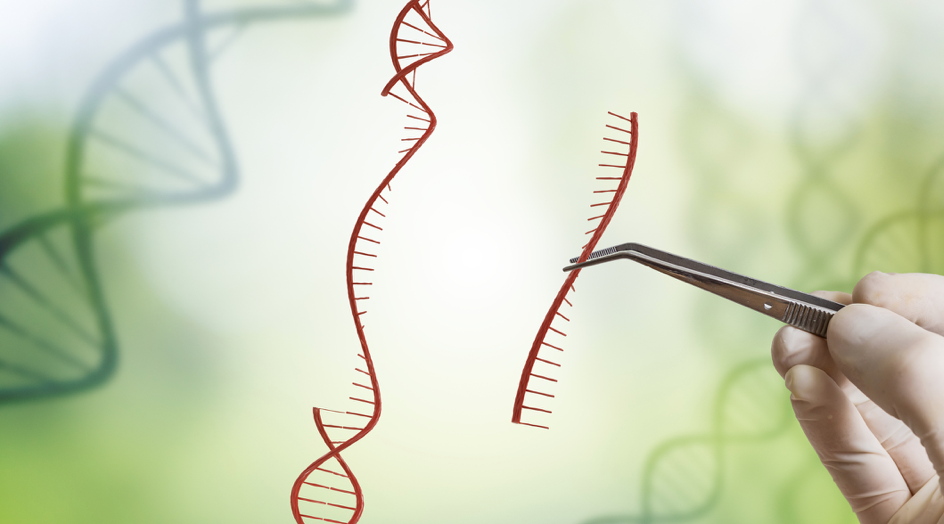
The American biochemist Jennifer Doudna is one of the creators of the breakthrough tool that allows genetic sequences to be edited. For In Vivo, she explains the technology, its applications and the resulting ethical challenges.
Eight years ago, Jennifer Doudna and her French colleague Emmanuelle Charpentier put the final touches on an innovative technique that allows DNA to be edited with disconcerting ease and precision. Known as CRISPR-Cas9, this major breakthrough and the attention it has received have upset the quiet life of a researcher who grew up with the rhythms of the Hawaiian surf. Doudna is now considered a candidate for a Nobel prize; she has founded three companies and is an active participant in the international ethical-legal dialogue on the potential consequences of this new technology. Indeed, CRISPR-Cas9 may revolutionise not only medicine but all of humanity.
There is a wide range of exciting medical applications. Examples of genetic diseases that researchers are actively working to address include sickle-cell disease, muscular dystrophy, and cystic fibrosis. Researchers are also deploying gene-editing technology to treat cancer. This procedure includes editing the body’s immune cells to aggressively and specifically target cancer cells as a way of improving the body’s natural response. This year, scientists in several different countries will begin clinical trials using CRISPR-Cas9, so we will watch anxiously as the boundaries of modern medicine are extended.
In addition to cancer, researchers are also attempting to use gene editing to alter a body’s microbiome. Some health abnormalities are caused by an imbalance of bacteria in the body or the introduction of harmful bacteria. Researchers are working to understand whether CRISPR-Cas9 proteins could be used to target harmful bacteria or use the bacteria’s own CRISPR-Cas9 system against itself as a way of self-destruction. Scrolling through the latest science papers, I’m always amazed by the new and exciting uses of gene editing that are being developed.
Xenotransplantation is the process of introducing cells or an organ from one species into another species. One use of gene editing in xenotransplantation is focused on growing human organs in pigs in order to address the shortage of organ donors. This process requires altering the DNA of the pig to prevent an undesirable immune response once the organ is implanted into the human.
Gene-editing technology can help treat cancer.
Yes. If the DNA of an embryo is edited, then as the cells divide each cell will carry that edit. As the embryo develops and generates its own sperm or eggs, these cells will also have the same edited DNA, passing down through future generations.
It means that with this tool we can precisely cut nearly any sequence of DNA in a wide range of organisms. We often use the word “edit” to describe this process because it draws parallels to how someone would edit a word document on a computer. The Cas9 protein is bound to a small RNA guide as a way to program the protein to target a specific sequence of DNA. Once the RNA identifies a complementary sequence DNA, then Cas9 is ready to make a cut. Such precision gives researchers the opportunity to add or remove specific DNA sequences. This process resembles finding one word within an entire novel and changing one letter in that single word.
Partly the ease and affordability of the technology. Although zinc finger nucleases can specifically recognise and cut a sequence of DNA, the process takes considerable time and money. Rather than engineering a protein to bind to a specific sequence of DNA, CRISPR-Cas9 is programmed by a small RNA guide. Researchers are able to swap in different guides to target any DNA sequence of interest, which saves both time and money.
Targeting a sequence of DNA can be as simple as designing the correct RNA guide.
Correct. Targeting a sequence of DNA can be as simple as designing the correct RNA guide. The difficulties from this point vary depending on the application of the technology. If a researcher is interested in editing liver cells to address a particular genetic disease, they must overcome the hurdle of delivering Cas9 to those cells. Researchers are also interested in using CRISPR-Cas9 gene editing to treat neurodegenerative diseases, which may require introducing Cas9 into the brain. Designing the correct RNA is just the beginning. There are many downstream questions that researchers are working hard to answer in order to achieve the full potential of this technology.
This is a question that many researchers are actively investigating. The method of delivery depends on the specific application. For example, scientists who are interested in treating sickle-cell disease attempt to remove stem cells from the body, correct the disease-causing gene, and reintroduce the cells back into the body. For many other diseases, removing cells from the body is not an option. Instead, researchers are developing ways to introduce Cas9 into the body and direct the protein to the correct cell.
Researchers have succeeded in using CRISPR-Cas9 gene editing in a wide range of organisms. Several larger members of the animal kingdom have had their genomes edited, including cows, dogs and chickens. In addition, this technology has been deployed to alter the DNA of plants. Technical limitations have arisen when editing plants because the outer walls of plant cells are significantly different from the membranes of animal cells. This has not stopped researchers from altering the DNA of several plants species, but considerable work lies ahead to edit the genomes of more plants.
I encourage a wide conversation about ethical issues.

There are still many aspects of intellectual and physical capacities that we don’t understand, including specifics about how these traits are coded in our DNA. Such “enhancement traits” are a product of many genes and also affected by the environment outside the body. Before making any attempt to enhance the human body, we need to fully understand these complicated traits. It’s important that everyone be aware of these future possibilities, and I encourage a wide conversation about such ethical issues.
Currently, CRISPR-Cas9 technology is not available to treat genetic diseases in humans or to make any desired enhancements. The safety of this technology is still being thoroughly tested. We have to continually test the safety of CRISR-Cas9 to ensure a complete understanding of any risks.
I’m excited about this technology’s potential for improving human health, engineering environmentally sustainable and nutritious food, and advancing scientific research.
It’s important for scientists to ponder and anticipate the potential uses of their discoveries and research. I’m pushing for CRISPR-Cas9 to be used ethically and I’m excited about this technology’s potential for improving human health, engineering environmentally sustainable and nutritious food, and advancing scientific research. I’ve also been fortunate to participate in national and international dialogues with regulators, policy makers, ethicists, and the general public about the potential consequences of gene-editing technology and believe that the understanding and acceptance of the technology as a strategy to better our society is growing.
Yes, fundamental biology that focuses on a wide range of biodiversity will likely continue to yield many exciting new discoveries.
I’ve benefitted from many wonderful collaborations. Such work is encouraged by large collaborative grants and stimulated by working in proximity with other fantastic scientists. In recent years, I’ve also had a chance to work closely with professors and experts in the humanities. Future collaboration between the sciences and humanities will be necessary to address many of the world’s most pressing problems.
Yes I am, alongside many talented collaborators. An area I’m particularly excited about includes the investigation of anti-CRISPRs – small proteins naturally made by viruses to bind to CRISPR-Cas9 proteins and prevent them from binding or cutting DNA.
I am humbled by the interest in the technology and my journey. I continue to focus on push-ing the limits of the technology and increasing public awareness and engagement.
American Jennifer Doudna is a professor in biochemistry and molecular biology at University of California, in Berkeley. In 2012, in collaboration with French researcher Emmanuelle Charpentier, she developed the gene editing tool known as CRISPR-Cas9. A discovery for which she earned many prestigious scientific awards ever since.